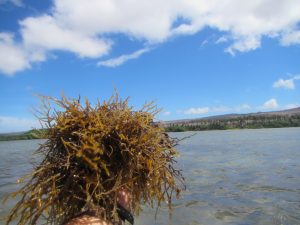Gorilla Ogo
Gorilla Ogo (Gracilaria salicornia)
Description:
- Small, solid, brittle, cylindrical to compressed, irregular branches with segmentation on each branch (UH Mānoa, 2001; EOR, 2015)
- Varies in color, from a bright yellow at the tips to orange, green, or brown at the base (EOR, 2015)
- Has been found to reproduce sexually and asexually (UH Mānoa, 2001)
Habitat:
- Grows in close proximity with neighboring benthic organisms to create thick mats and clumps that can be up to 30 centimeters (cm) or more across, and up to 40 cm thick (UH Mānoa, 2001; CABI, 2019)
- Typically found in tidepools and on reef flats, up to four meters underwater (UH Mānoa, 2001)
Impacts & Concern:
- Widespread dispersal mainly through fragmentation (CABI, 2019; UH Mānoa, 2001)
- Fragments are heavy and tend to sink rapidly but remain viable after more than 6 hours desiccation (Smith et al., 2004)
- Outcompetes native algae and coral and can overgrow areas, shading it from sunlight (CABI, 2019)
- Can cause ecosystem changes by shifting Hawaiian reefs from coral dominated to algae dominated, leading to low biodiversity (CABI, 2019)
- Loss of the ecosystem services and structure provided by live coral (CABI, 2019)
Introduction:
- First identified in 1971on Hawai’i Island in Hilo Bay, where it was likely unintentionally introduced by shipping vessels originating from the Philippines (UH Mānoa, 2001; CABI, 2019)
- In April 1971, G. salicornia was transported intentionally from Hilo to Waikiki
- In September 1978 it was transferred to Kāne‘ohe Bay on O‘ahu for aquaculture projects that were later abandoned (UH Mānoa, 2001)
Distribution in Hawaii:
- Kauai: Not documented
- O‘ahu: Waikīkī, Pearl Harbor, Maunalua Bay, and Kāne‘ohe Bay (Smith et al., 2004)
- Molokai: Present, Specific Areas Unknown (UH Mānoa, 2001)
- Lanai: Not documented
- Maui: Not documented
- Big Island: First discovered in Hilo Harbor, now spread south along the coast (EOR, 2015)
Related AIS Team Management Projects:
References:
- Smith, J., Hunter, C., & Conklin, E. (2004). Ecology of the Invasive Red Alga Gracilaria salicornia (Rhodophyta) on O‘ahu, Hawai‘i. Pacific Science, 58(2), 325-343.
- UH Mānoa. (2001). Gracilaria salicornia. Marine Algae of Hawaiʻi. https://www.hawaii.edu/reefalgae/invasive_algae/rhodo/gracilaria_salicornia.htm
- CABI. (2019). Gracilaria Salicornia. In: Invasive Species Compendium. Wallingford, UK: CAB International. https://www.cabi.org/isc/datasheet/107771
- Eyes of the Reef (EOR). (2015). Gorilla Ogo (Gracilaria Salicornia). Eyes of the Reef Hawaiʻi. https://eorhawaii.org/education/marine-invasive-species/gorilla-ogo/
